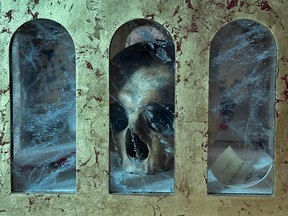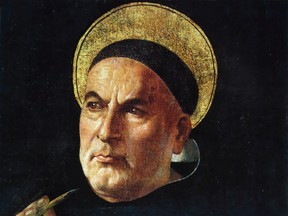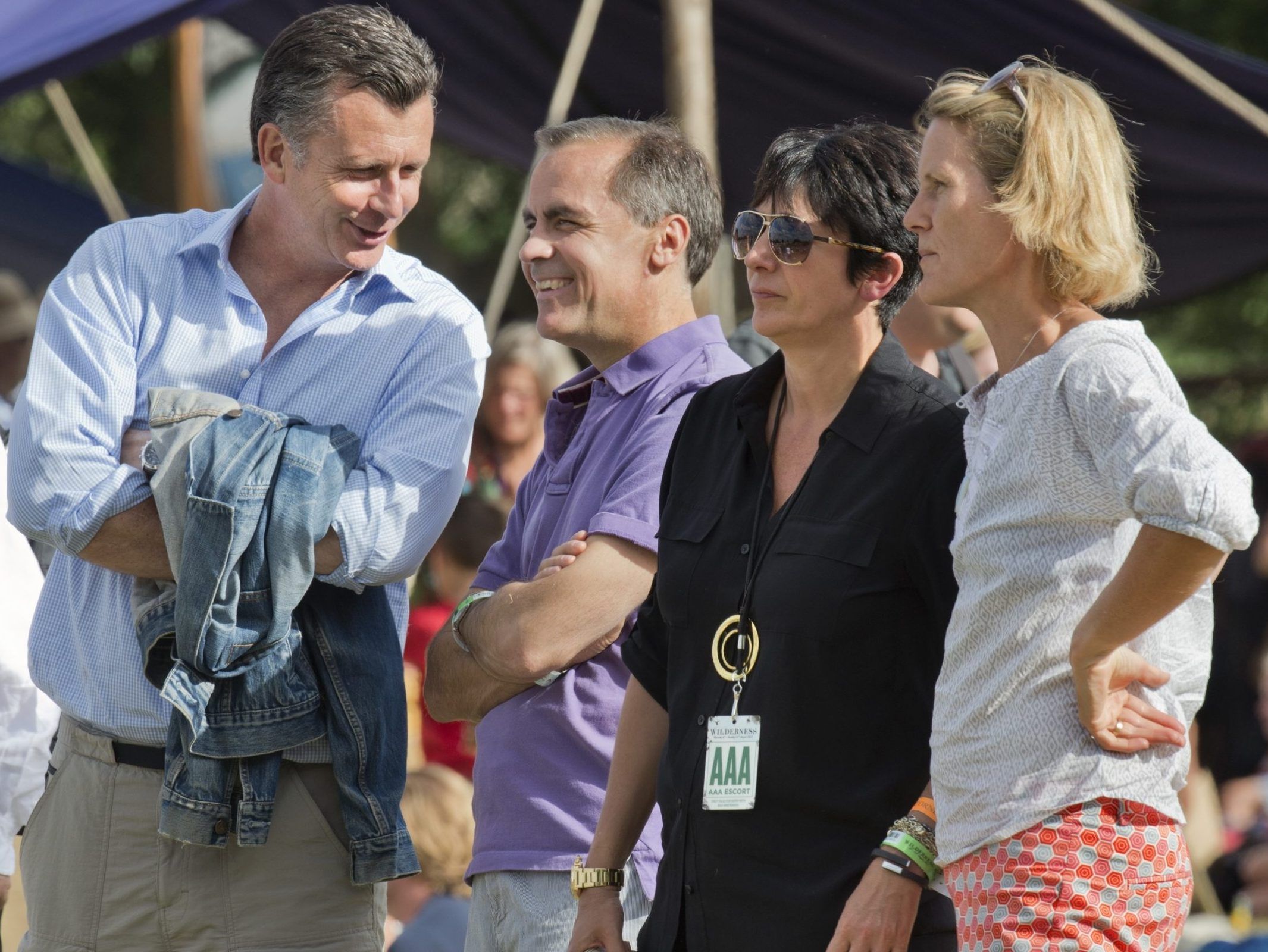For Christians, this touring relic of the medieval philosopher is a reminder of life's promise. While bodily relics are not uniquely Christian, seeing them as especially celebratory is
Published Dec 26, 2024 • Last updated 6 minutes ago • 7 minute read

When you think about it, looking a skull square in the empty eye sockets can seem pretty creepy. Macabre, perhaps. Definitely dark. Father Ambrose Little realizes this.
But when the cranium of the medieval Christian philosopher Thomas Aquinas comes to visit, the mood is actually quite joyous, and not just for Dominican friars like Little. For the hundreds of people who came to kneel before it at St. Dominic’s Church in Washington, D.C., last month, it was exciting, like a pilgrimage. But it was no funeral.
Advertisement 2
THIS CONTENT IS RESERVED FOR SUBSCRIBERS
Enjoy the latest local, national and international news.
- Exclusive articles by Conrad Black, Barbara Kay and others. Plus, special edition NP Platformed and First Reading newsletters and virtual events.
- Unlimited online access to National Post and 15 news sites with one account.
- National Post ePaper, an electronic replica of the print edition to view on any device, share and comment on.
- Daily puzzles including the New York Times Crossword.
- Support local journalism.
SUBSCRIBE FOR MORE ARTICLES
Enjoy the latest local, national and international news.
- Exclusive articles by Conrad Black, Barbara Kay and others. Plus, special edition NP Platformed and First Reading newsletters and virtual events.
- Unlimited online access to National Post and 15 news sites with one account.
- National Post ePaper, an electronic replica of the print edition to view on any device, share and comment on.
- Daily puzzles including the New York Times Crossword.
- Support local journalism.
REGISTER / SIGN IN TO UNLOCK MORE ARTICLES
Create an account or sign in to continue with your reading experience.
- Access articles from across Canada with one account.
- Share your thoughts and join the conversation in the comments.
- Enjoy additional articles per month.
- Get email updates from your favourite authors.
THIS ARTICLE IS FREE TO READ REGISTER TO UNLOCK.
Create an account or sign in to continue with your reading experience.
- Access articles from across Canada with one account
- Share your thoughts and join the conversation in the comments
- Enjoy additional articles per month
- Get email updates from your favourite authors
Article content
On the contrary, this is a whirlwind itinerary to celebrate the 800th anniversary of Aquinas’s birth and 750th of his death, which took the skull in its reliquary onward to Virginia, Rhode Island, Ohio, Kentucky, New York and Maryland, all before Christmas. Normally, it is kept in Toulouse in southern France, original home of the Order of Preachers, better known as Dominican friars or Black Friars, of which Aquinas, who was born in Italy and worked much of his life in Paris, is the all-time most famous.
“It reminds me of the special grace of God, that we are in the presence of a vessel that used to hold such a profound mind,” said Little, assistant professor of philosophy at the Dominican House of Studies and acting director of its Thomistic Institute. “Here is the head that used to hold the brain that gave the world such beautiful explanations of God.”
It’s a matter of perspective, whether this empty cranium reminds you of death or life.
For the wider culture, a skull is a physical metaphor of death, like Hamlet beholding the skull of the poor dug up dead jester Yorick and feeling like he’s about to vomit. Little thinks seeing the skull in this way, as macabre and gothic and creepy, is a “totally reasonable” response from a purely secular perspective.
By signing up you consent to receive the above newsletter from Postmedia Network Inc.
Article content
Advertisement 3
Article content
It’s just not how he sees it. For the Christian, he said, this relic is a reminder of the promise of life. Aquinas is a saint who is now with God, destined to receive his body back at the Last Judgment. To kneel in the presence of his relic is therefore to connect with God in a special way. As he puts it, a natural devotion to this skull facilitates a supernatural devotion to God. On this view, nothing could be less creepy.
Bodily relics are not uniquely Christian. Some Muslims venerate strands of the prophet Muhammad’s beard. Even determinedly secular cultures keep the preserved remains of distinguished people on display long after their deaths. Vladimir Lenin’s body is in a mausoleum on Red Square in Moscow, for example, and atheist philosopher Jeremy Bentham’s body is in the student centre of University College London.

But Christians are unique in seeing relics as especially celebratory, Ambrose said, because of the central belief in resurrection. From the earliest days of Christian persecution in the Roman Empire, relics of saints and martyrs took on a powerful relevance, with old graves becoming sites of new churches. As the faith grew in political and economic power, the European trade in relics was extensive, particularly after the loss of control over Jerusalem, when the physical remnants of the central events of Christianity seemed increasingly distant. Relics brought it all close again. This reached a peak in Aquinas’s lifetime, when the French King Louis IX built the Sainte-Chapelle, a gothic royal chapel in Paris to house relics including the reputed crown of thorns placed by Roman soldiers on Jesus’s head to mock him before execution.
Advertisement 4
Article content
Most European churches from this period have relics, as diverse as the trachea of St. Anthony of Padua, the shoulder blade of St. Catherine of Siena, and various bones of St. Peter in Rome and St. Mark in Venice.
In his book Cult Of The Dead: A Brief History of Christianity, the University of Toronto historian of Christianity Kyle Smith writes: “none of these things was just a memento of an irretrievable past; all were timeless points of intersection where the holy and the human converged. Saints led a double existence through their relics: present on earth while being glorified in heaven. Relics were an earthly portal to paradise.”
It is curious that they still draw crowds today. But they do.
Some relics are venerated despite uncertain authenticity. For example, there is a second purported Aquinas skull relic at a church in Italy that is also officially venerated in the Catholic Church, because both have a plausible claim to be the true one and testing has not yet determined which one is not.
It is fertile ground for jokes. The great American writer Mark Twain once toured the Holy Land and wrote about it in 1869, saying he found “this relic matter” is “a little overdone.… We find a piece of the true cross in every old church we go into, and some of the nails that held it together. I would not like to be positive, but I think we have seen as much as a keg of these nails.”
Advertisement 5
Article content
Likewise, there is a venerated tooth of the Buddha in a temple in Singapore that is plainly too big to be a human tooth.
But many saintly relics on modern display are exactly what they claim to be: physical remnants of the noble dead. They can be confusing as much as creepy.
Mindful of this, Father Gregory Pine, an instructor in theology at the Dominican House of Studies, gave a sermon to pilgrims on how to venerate the Aquinas relic, and how not to.
Seeing Aquinas’s skull reminds us that all that we do pales in eternity
First off, he said in an interview, this is not idolatry. The idea is not to regard the relic as an “end in itself.” You don’t pray to this skull. It is not magic. You might bow before it, but not exactly to it.
Second, Gregory said, avoid the temptation to phrenology. Don’t examine the physical shape for clues to the ideas about God. Aquinas was famously a big man, nicknamed the Dumb Ox on account of his size and demeanour. But in Pine’s Christian view, Aquinas’s intellect and will were not fully “encompassed” by the corporeal organ of his brain. So looking for clues to his ideas in the shape of his skull is not only bad physiological and psychological science. It is also bad theology, a misunderstanding of veneration.
Advertisement 6
Article content
“If you want to care about Thomas, then care about what he cared about, which is God,” Pine said.
As a philosopher and theologian, Aquinas is famous for many ideas, including the ethical conditions of a just war. He summarized five influential philosophical proofs for God, such as the idea that all motion comes from somewhere, so there must be an unmoved first mover. “Et hoc dicimus Deum,” Aquinas wrote in Latin. “And this we call God.”
Aquinas “looks on God and thinks on God with a clarity and precision which affords us precious tools and resources for us to think about God,” said Pine.
Drawing on Islamic scholarship that preserved the classical Greek philosophy of Aristotle, Aquinas moved medieval European Christianity away from the view that the world is best understood as a pale reflection of timeless pure truths, toward a philosophy more concerned with the natural purpose of things, discoverable by reason. Broadly, Aquinas reconciled human reason with Christian faith, and remains today as influential as any Christian philosopher before or since.
It is therefore humbling to be in the presence of his skull, Little said. He teaches philosophy, especially Aquinas, and the skull reminds him that his own ideas will fade, and that his work as a scholar and philosopher is “secondary” to his work as a priest, which will have an “eternal echo,” he said.
Advertisement 7
Article content
“So seeing Aquinas’s skull reminds us that all that we do pales in eternity. What makes the skull so important is not that it held mind and truth, but that it held the mind of saint who will receive his body back on the last day,” Little said. “That, too, is a powerful reminder to contextualize our work.”
One of the most famous stories about Aquinas is about a strange transcendent experience he had during a mass, which left him struck silent. He is reported to have said that, after this experience, all his words are like straw. He died soon after.
Ambrose said he has been reflecting on this straw metaphor to prepare for the arrival of the skull.
There is the obvious modern view that straw is somehow worthless, as if it could be scattered by the wind. Comparing words to straw is like comparing them to dust.
But there is another view, that straw can be tinder to catch a flame. It is not valuable in itself, but like thoughtful words, it is valuable for what it can do.
“What it does is to help the mind catch the flame of the love of God,” Little said.
That’s what he sees in the dark hollows of those empty sockets: a light.
Recommended from Editorial
-

The holy and uncorrupted arm of St. Francis Xavier tours Canada (2018)
-

Santa just a big ad for Coca Cola, Italian bishop tells pupils
Our website is the place for the latest breaking news, exclusive scoops, longreads and provocative commentary. Please bookmark nationalpost.com and sign up for our daily newsletter, Posted, here.
Article content
.png)
 2 weeks ago
15
2 weeks ago
15




































 Bengali (BD) ·
Bengali (BD) ·  English (US) ·
English (US) ·